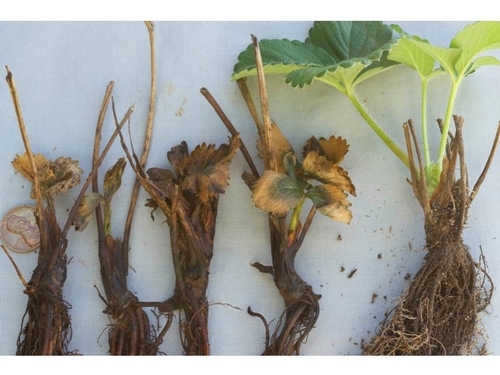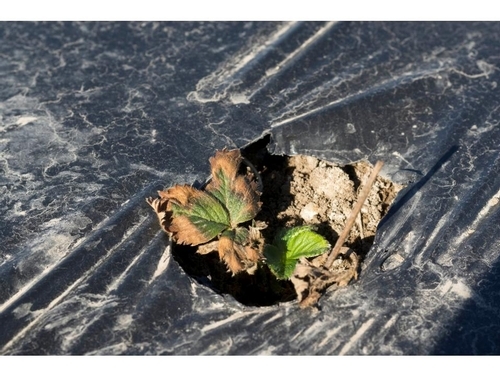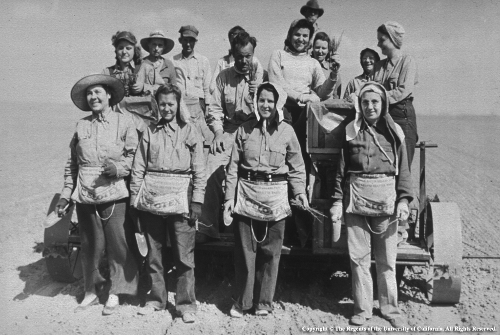Strawberries
2014 Strawberry Production Research Meeting Announcment
Announcing the 2014 Strawberry Production Research Meeting this coming February 4. Plenty of talks on the topics that concern strawberry growers the most these days- new varieties, growing strawberries, managing lygus, diseases and viruses.
Link to agenda posted below.
http://cesantacruz.ucanr.edu/files/178466.pdf
Heads Up About the Potential for Salt Damage in Berries
People should be super aware right now that the lack of rain we are experiencing is certain to exacerbate salt problems in berries this winter. I’ve been driving around a bit visiting fields, growers and PCA’s and the problem doesn’t yet seem too bad although I am starting to see a little bit of damage here and there. Still, I have a strong sense of foreboding that this could get big as the season progresses on the Central Coast without any rain.
See the pictures below from colleague Steven Koike for what salt damage looks like in strawberries.
Key points to keep in mind regarding winter management of salinity (Many thanks to Dr. Stuart Styles from Cal Poly in San Luis Obispo for giving me a copy of the entire data notebook of his work on salinity in strawberries from which I draw the points below - I treasure this book and it has been very useful to my understanding of this topic):
1. Salinity is a key determinant in the healthy establishment of strawberry transplants, and young plants do not tolerate elevated levels of salinity for very long. Certain literature seems to say that soil salinity EC of above 4.0 dS/m would result in total loss of fruit yield, but Dr. Style’s work demonstrates this is going to depend where exactly this salinity is to be found. His work and my own experience in the field informs us that if the grower acts quickly and the salinity is kept away from the roots, the effect on fruit yield could be much less.
2. Salts come from various sources including irrigation water, gypsum, fertilizers and especially composting (which is why I think we tend to see more salt damage in organically farmed berries).
3. Rain has a HUGE effect on soil salinity. According to the work of Dr. Styles and his colleagues, a single heavy rain can lower soil salinity by 50%; less so because of the quantity of water but because the rainwater has a low pH and zero salt content.
4. Salinity of irrigation water has a real impact on fruit yields. Water salinity of less than 1.0 dS/m will have very little impact on yield, but as the irrigation water salinity creeps over 1.2 dS/m the effect can be substantial.

Picture showing the progression of salt damage in strawberry transplants. Photo courtesy Steven Koike, UCCE.

Close up of strawberry transplant experiencing high soil salinity. Note burnt appearance of leaf margins. Also of note is salty residue on the black bed plastic. Photo courtesy Steven Koike, UCCE.
Powerpoint Presentations from Fumigation Alternative Symposium Now Available
Most of the Powerpoint presentations from yesterday's Fumigation Alternative Symposium are now available:
http://ucanr.edu/2013 fumigation alt symposium
Really great meeting by the way, many thanks to the Strawberry Commission for organizing, to each of the presenters for presenting and participants for coming out and being part of it!
Immigration Reform and California Agriculture
Really great article here by UC Davis' Philip Martin concerning immigration reform bills and what they might mean for the labor situation in the agriculture of California.
http://californiaagriculture.ucanr.org/landingpage.cfm?article=ca.v067n04p196&fulltext=yes
Interestingly, it looks like the longer periods of US employment permitted by one bill, S 744, as well as the opportunity for immigrants to bring family with them, could result in a larger number of people coming here from Asia to work.
Might be a signal to start learning Mandarin Chinese.

What might the immigration reform bills making their way through Congress mean for field labor in California?
A Word About these Cold Temperatures and our Berries
As we look to be in for some freezing temperatures for the next couple of days on the Central Coast, it is a good time to review what sort of frost protection would be necessary for our berry crops.
The real key right now is that pretty well our entire berry crop is free of flowers, which would be the plant organ most susceptible to freezing and subsequent loss. With some exceptions, raspberries and blackberries have dropped their leaves and are growing very little, if at all. With strawberries, there might be some concerns about newly emerged leaves experiencing some frost damage, but the temperatures being discussed right now being in the low 20’s, I just don’t see there being any freeze damage to the crown and subsequently damaging the plant for the long term.
Be that as it may, it is still good to know what to do if the concern does arise about a frost causing damage to a berry crop. I had a great discussion with my colleague Steve Tjosvold at the office this morning, and really the best option is to load the bed with water during the day by irrigating it (drip is fine), allowing the bed to accumulate heat which will then be radiated out of the moistened soil during the night, keeping the immediate environment around the plants warmer than the ambient freezing temperatures.
For fuller, in depth discussion, see the excellent summary attached below:

